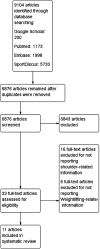Shouldering the load: A scoping review of incidence, types, and risk factors of shoulder injuries in weight-lifting athletes
- PMID: 39552690
- PMCID: PMC11562226
- DOI: 10.1177/17585732241258743
Shouldering the load: A scoping review of incidence, types, and risk factors of shoulder injuries in weight-lifting athletes
Abstract
Lifestyles advocating for proper health and fitness have been trending in recent years, and as such, sports like weightlifting have become very popular worldwide. While these sports improve physical fitness and cardiovascular health, they carry an inherent risk for physical injuries, mainly to the shoulder. In this review, we aimed to explore the epidemiology of shoulder injuries in weightlifting using a systematic search of the literature. The databases PubMed, Google Scholar (pages 1-20), Embase, and SPORTDiscus were queried using relevant search terms to extrapolate all studies pertaining to shoulder injuries in these two sports. Shoulder injuries turned out to be common in both sports with varying incidence rates and were shown to occur to athletes independent of gender and age. Anterior instability and overuse injuries were the most common injury types, and presentation varied with regards to symptoms and severity. Both intrinsic and extrinsic factors can contribute to shoulder injuries in the setting of these two sports, including incorrect implementation of techniques, age, vulnerable positioning of the shoulder during the lift, and overtraining which leads to overuse injuries.
Keywords: powerlifting; shoulder injuries; weightlifting.
© The Author(s) 2024.
Conflict of interest statement
The author(s) declared the following potential conflicts of interest with respect to the research, authorship, and/or publication of this article: JAA would like to disclose: Royalties from a company or supplier; Disclosures; OSTEOCENTRIC TECHNOLOGIES, ENOVIS, ZIMMER-BIOMET, STRYKER, GLOBUS MEDICAL, INC. Stocks in: SHOULDER JAM, AEVUMED, OBERD, OTS MEDICAL, ORTHOBULLETS, ATREON, RESTORE 3D. Research support from a company or supplier as a PI; Disclosures; ENOVIS, ARTHREX. Royalties, financial or material support from publishers; Disclosures; WOLTERS KLUWER, SLACK ORTHOPAEDICS, ELSEVIER. Board member/committee appointments for a society; Disclosures; AMERICAN SHOULDER AND ELBOW SOCIETY, MID ATLANTIC SHOULDER AND ELBOW SOCIETY, SHOULDER 360, PACIRA.
Figures
Similar articles
-
Injuries in weightlifting and powerlifting: an updated systematic review.BMJ Open Sport Exerc Med. 2024 Dec 4;10(4):e001884. doi: 10.1136/bmjsem-2023-001884. eCollection 2024. BMJ Open Sport Exerc Med. 2024. PMID: 39650568 Free PMC article.
-
The Epidemiology of Injuries Across the Weight-Training Sports.Sports Med. 2017 Mar;47(3):479-501. doi: 10.1007/s40279-016-0575-0. Sports Med. 2017. PMID: 27328853 Review.
-
Risk Factors of Overuse Shoulder Injuries in Overhead Athletes: A Systematic Review.Sports Health. 2020 Sep/Oct;12(5):478-487. doi: 10.1177/1941738120931764. Epub 2020 Aug 6. Sports Health. 2020. PMID: 32758080 Free PMC article.
-
Sports-Related Shoulder Injuries Among Female Athletes.Curr Rev Musculoskelet Med. 2022 Dec;15(6):637-644. doi: 10.1007/s12178-022-09802-2. Epub 2022 Dec 5. Curr Rev Musculoskelet Med. 2022. PMID: 36469281 Free PMC article. Review.
-
[Acute and overuse injuries of the shoulder in sports].Orthopade. 2014 Mar;43(3):202-8. doi: 10.1007/s00132-013-2141-x. Orthopade. 2014. PMID: 24567176 Review. German.
References
-
- Eather N, Morgan PJ, Lubans DR. Improving health-related fitness in adolescents: the CrossFit TeensTM randomised controlled trial. J Sports Sci 2016; 34: 209–223. - PubMed
-
- Westcott WL. Resistance training is medicine. Curr Sports Med Rep 2012; 11: 209–216. - PubMed
-
- Daher M, Farraj SA, Youssef B, et al. Unhappy triad of the knee : a narrative review. SVOA-OR 2022; 2: 50–54.
Publication types
LinkOut - more resources
Full Text Sources

